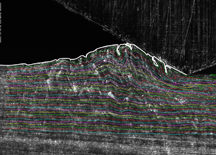Sliding metals show fluidlike behavior, new clues to wear
September 11, 2012
 |
|
This frame from a high-speed camera sequence reveals
surprising behavior in a solid piece of metal sliding over another. The
research is providing new insights into the mechanisms of wear and generation
of machined surfaces that could help improve the durability of metal parts.
(Purdue University School of Industrial Engineering image/N. Sundaram and Y.
Guo) |
WEST LAFAYETTE, Ind. – Researchers have discovered a swirling, fluidlike behavior in a solid piece of metal sliding over another, providing new insights into the mechanisms of wear and generation of machined surfaces that could help improve the durability of metal parts.
Studies using a microscope and high-speed camera revealed the formation of bumps, folds, vortexlike features and cracks on the metal surface. The findings were surprising because the experiment was conducted at room temperature and the sliding conditions did not generate enough heat to soften the metal.
"We see phenomena normally associated with fluids, not solids," said Srinivasan Chandrasekar, a Purdue University professor of industrial engineering who is working with postdoctoral research associates Narayan Sundaram and Yang Guo.
Numerous mechanical parts, from bearings to engine pistons, undergo such sliding.
"It has been known that little pieces of metal peel off from sliding surfaces," Chandrasekar said. "The conventional view is that this requires many cycles of rubbing, but what we are saying is that when you have surface folding you don't need too many cycles for these cracks to form. This can happen very quickly, accelerating wear."
Findings are detailed in a research paper published in the Sept. 7 issue of Physical Review Letters. The magazine featured the research on the cover and also included a Viewpoint commentary about the work (http://physics.aps.org/articles/v5/100).
The researchers are developing models to further study the phenomena and understand the wide-ranging consequences of such fluidlike flow in metals, Chandrasekar said. The findings might also lead to improved surface quality in materials processing.
The team observed what happens when a wedge-shaped piece of steel slides over a flat piece of copper. It was the first time researchers had directly imaged how sliding metals behave on the scale of 100 microns to 1 millimeter, known as the mesoscale.
The observations show how tiny bumps form in front of the steel piece, followed by the swirling vortexlike movement and then the creation of shallow cracks. The folding and cracking were most pronounced when the steel piece was held at a sharp angle to the copper surface.
The researchers hypothesize that the folding and cracking are due in part to a phenomenon similar to "necking," which happens as a piece of metal is stretched.
Researchers used a specialized laboratory setup that included a high-speed camera and equipment that applies force to the sliding metals. The behavior was captured in movies that show the flow in color-coded layers just below the surface of the copper specimen. Copper is commonly used to model the mechanical behavior of metals.
"Researchers have never had a good experimental setup to observe this kind of deformation directly," Guo said. "Our setup enables us to see the entire history of this fluidlike behavior as it occurs, whereas more conventional experiments rely on still images taken after the experiment is finished."
Metals are made of groups of crystals called grains. Metal surfaces that have smaller grains may be less susceptible to the folding and crack formation.
"We need to explore what role grain size plays," Chandrasekar said. "We think there should be some grain size below which this folding mechanism might be less active. We need to explore why - under what conditions - solid metals behave like fluids."
The research has been funded by the National Science Foundation, U.S. Army and General Motors.
Writer: Emil Venere, 765-494-4709, venere@purdue.edu
Sources: Srinivasan Chandrasekar, 765-494-3623, chandy@purdue.edu
Narayan K Sundaram, nsundara@ecn.purdue.edu
Yang Guo, guo24@purdue.edu
Note to Journalists: A copy of the research paper is available by contacting Emil Venere, 765-494-4709, venere@purdue.edu
ABSTRACT
Mesoscale Folding, Instability and Disruption of Laminar Flow in Metal Surfaces
Narayan K. Sundaram,* Yang Guo, and Srinivasan Chandrasekar
Center for Materials Processing and Tribology, Purdue University
Using in situ imaging, we report surface fold formation and fluidlike flow instabilities in sliding of annealed copper. We demonstrate using simulations that folding is principally driven by grain-induced plastic instability. The phenomenon shows remarkable similarities with Kelvin-Helmholtz-type flow instabilities in fluids. While such instabilities have been conjectured to exist in sliding interfaces at the nanoscale, we find vortices and folding in metals at the mesoscale. The occurrence of folds impacts many applications, including surface generation processes and tribology.

